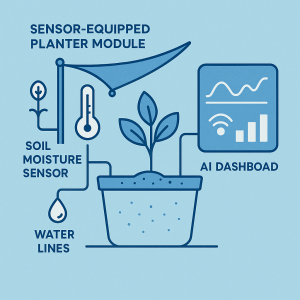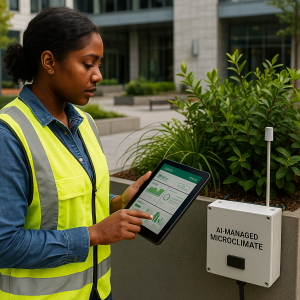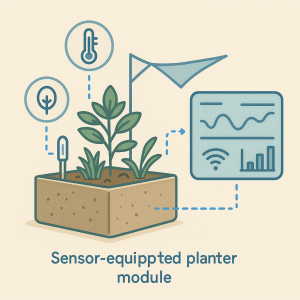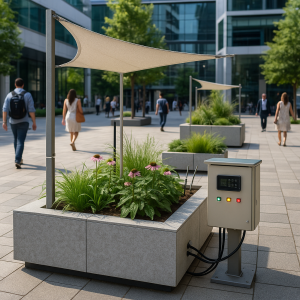Commercial landscapes are undergoing a data‑driven makeover. Beyond static plantings and manual maintenance, today’s leading-edge properties demand dynamic solutions that respond to real-time shifting environmental conditions. Enter AI‑Managed Microclimate Planting Modules—self‑contained planter pods bristling with sensors and actuators, all orchestrated by a central AI brain. These modules optimize soil moisture, light exposure, temperature, and airflow on the fly, ensuring plants thrive under conditions they wouldn’t usually tolerate. Scalable, plug‑and‑play, and rich in actionable analytics, microclimate modules are gaining traction at campuses, hotels, and commercial plazas around the globe.

How It Works
- Sensor Array: Each module houses a suite of miniaturized sensors: soil moisture probes, ambient temperature and humidity gauges, and photosynthetically active radiation (PAR) detectors. These sensors stream data every few minutes to a local gateway.
- AI Control Engine: A cloud‑based AI platform aggregates sensor feeds, historical weather patterns, and plant‑specific water‑use models. Machine‑learning algorithms predict stress events (e.g., drought, heat spikes) and calculate precise intervention strategies.
- Automated Actuators: Based on AI directives, micro‑pumps deliver exact volumes of water and liquid nutrients through driplines. Retractable shade sails or UV‑resistant film adjust overhead light levels, while miniature fans or vents regulate airflow and temperature.
- Dashboard & Alerts: Facility managers access a web or mobile dashboard showing real‑time module statuses, health scores, and maintenance alerts. Predictive insights—like “forecasted soil dryness in 12 hours”—help schedule proactive care.

Case Studies
- Silicon Valley Tech Campuses
- A major tech firm piloted 50 microclimate modules in its central courtyard. By dynamically misting and deploying shade sails during midday heat, the pods lowered ambient temperatures by up to 5 °C, creating comfortable outdoor meeting zones and reducing adjacent building cooling costs by 8 %. Plant stress events dropped by 70 %, virtually eliminating emergency irrigation runs.
- Dubai Luxury Hotels
- In the Middle East’s arid climate, a five‑star hotel chain installed edible‑wall modules stocked with herbs and microgreens. The AI system managed nutrient dosing and humidity control to sustain harvests year‑round. Culinary teams now enjoy a 30 % uplift in on‑site herb production, while guests rave about the “hyper‑fresh” flavours—an Instagram‑worthy amenity that boosted social media engagement by 25 %.
- Urban Rooftop Gardens in Vancouver
- A pilot project in downtown Vancouver deployed modules on a concrete rooftop to showcase climate‑resilient ornamentals. The AI adjusted watering schedules around frequent Pacific Northwest rains, preventing root rot and optimizing drainage. Maintenance time dropped by 40 %, and the green roof achieved stormwater retention targets 20 % above design specifications.

Benefits & Challenges
- Benefits
- Scalability & Flexibility: Modules can be deployed incrementally, so there is no need to overhaul entire landscapes.
- Resource Efficiency: Precise water and nutrient delivery slashes waste and utility costs.
- Enhanced Plant Resilience: Continuous micro‑adjustments mitigate stress from heatwaves, sudden downpours, or dry spells.
- Data‑Driven Management: Analytics dashboards transform gut‑feel decisions into measurable ROI metrics.
- Challenges
- Upfront Investment: Hardware, sensors, and AI subscriptions can cost tens of thousands per site.
- Technical Complexity: Integration with existing irrigation and building‑management systems may require specialized contractors.
- Data Security & Reliability: Cloud connectivity must be robust; outages can disrupt the AI feedback loop.
- Plant Selection Constraints: Modules excel with high‑value ornamentals or edibles but may be overkill for hardy groundcovers.

Actionable Takeaways
- Start Small: Pilot 10–20 modules in high‑visibility areas—plazas, lobbies, or rooftop lounges—to prove ROI before scaling.
- Choose Targeted Use Cases: Prioritize zones with extreme microclimate swings (e.g., full sun courtyards, wind‑exposed rooftops).
- Partner Wisely: Work with integrators who understand horticulture and IoT hardware—avoid one‑size‑fits‑all vendors.
- Train Staff: Empower grounds crews with dashboard walkthroughs so they can interpret alerts and perform simple troubleshooting.
- Monitor KPIs: Track metrics like water savings, plant‑failure rates, energy bill impacts, and guest or tenant feedback to build a compelling business case.
Future Outlook
As sensor costs fall and AI algorithms grow more sophisticated, microclimate modules will integrate seamlessly with Building Management Systems (BMS), lighting controls, and renewable‑energy microgrids. Expect next‑gen features like biometric guest‑driven scent diffusion, microbe‑based soil health management, and autonomous drone‑based module servicing. For commercial landscape managers, AI‑Managed Microclimate Planting Modules represent a trend and a paradigm shift toward smarter, greener, and more responsive outdoor environments.
